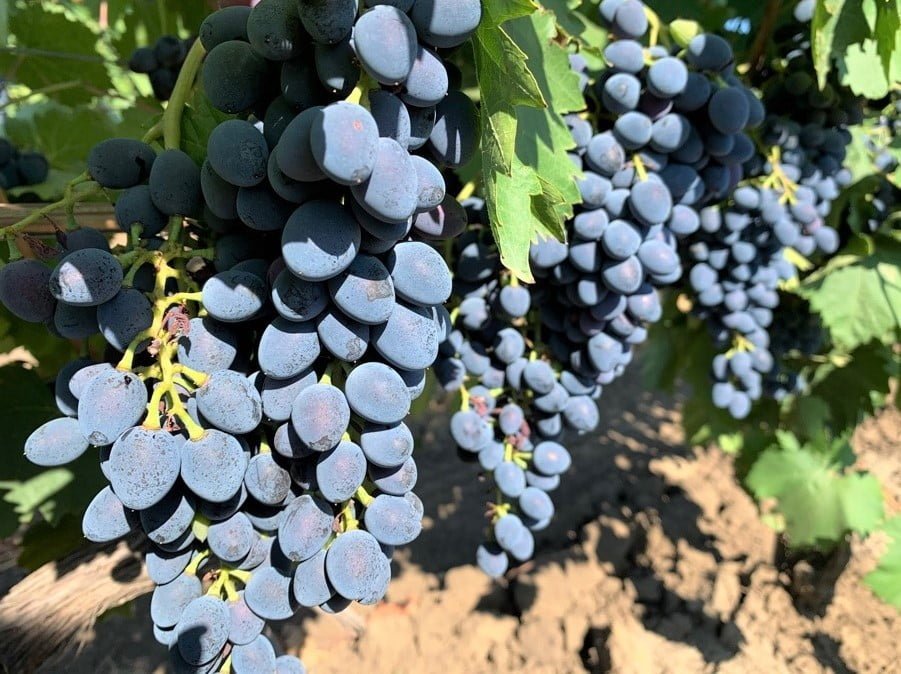Last week, harvesting of table grapes of the main late variety “Moldova” began in some southern and central regions of the Republic of Moldova. At the moment, the table grapes are harvested mainly from rain-fed plantations. Harvesting the highest quality Moldova grapes from the most intensive vineyards, formed according to the Pergola type and equipped with irrigation systems, starts at the end of the first week of October, EastFruit analysts report. Let’s consider the situation with prices, the level of demand for the first batches, and the prospects for production volumes and quality of grapes.
Experts from wine-growing organizations note that, despite the drought, the production of table grapes in Moldova this year will be at least not lower than last year, i.e. the amount of commercial products will most likely exceed 100 thousand tons. But at the same time, the quality of the products will be heterogeneous.
On the one hand, the viticulture industry was positively impacted by the fact that at the beginning of the year, many wineries announced to winegrowers a radical reduction in purchases of table grapes for the 2023 harvest. In the previous two seasons, wineries accepted table grapes, sometimes at very high prices – 5-7 lei/kg ($0.28-0.39/kg). According to expert estimates, wineries purchased 8-10 thousand tons of table grapes in previous seasons. This year, only a few factories announced their intention to purchase a very small amount of Moldova, and the purchase price is unlikely to seem attractive to any growers – up to 2 lei/kg ($0.11/kg). Therefore, from the beginning of the season, many farmers responsibly followed agricultural technologies, expecting to supply products exclusively to the “fresh market.”
On the other hand, since mid-summer in Moldova, conditions for grape growing have not been the best – the weather is too dry and hot. However, in August, short-term but heavy rains occurred in Moldova. In some wine-growing regions south of the country, up to 100 mm of precipitation fell in two days. As a result, very favorable conditions arose for the spread of diseases, particularly oidium. At the same time, winegrowers, due to high soil moisture on the plantations, were not always able to carry out preventive sanitation treatments – measures were often taken at a late stage of disease development, which negatively affected the quality of the products.
See also: Moldova’s 2023 apple harvest revised downward – problems with size and quality are also expected
Infestation with oidium leads to rapid “aging” of the produce – the ridges (branches) of the bunches begin to dry out and darken just four to five days after they were picked from the bush. This does not greatly affect the product’s organoleptic characteristics, but its appearance naturally suffers. Retailers are very reluctant to buy such grapes since consumers react negatively to the presence of a darkened branch.
However, according to the observations of specialists from wine-growing associations, the share of commercial grapes affected by oidium in the total harvest will be relatively small. Overall, the quality of Moldova grapes will be average or above average. The main disadvantages include only the relatively small sizes of bunches and berries, but only on farms growing grapes without irrigation, especially if the crop load was not regulated there.
Interestingly, since last week, some farms and traders have begun exporting Moldova grapes. First-harvest grapes of average quality are purchased for 7-8 lei/kg ($0.39-0.45/kg), which can be regarded as a good price offer for such a product. Moldova grapes are exported mainly to EU countries such as Poland, Romania, and Latvia. The first batch of Moldova grapes has already gone even to distant Mongolia. Probably, deliveries of this product to the Russian market have also begun.
There are practically no offers of Moldova grapes on the internal “fresh market” of Moldova itself. However, a year earlier, the first wholesale quantities of grapes of this variety went on sale only in early October at prices starting from 8 lei per kg. Most often, the sales season for Moldova grapes on the country’s wholesale markets begins around September 20, and prices start at 40-50 US cents.
The use of the site materials is free if there is a direct and open for search engines hyperlink to a specific publication of the East-Fruit.com website.




